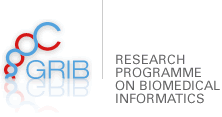
Sunday, 3rd October, 2010, 17h - 18h
The development of computational frameworks to explore the role of the pulsatile haemodynamic environment on the development of cerebral aneurysms for patient-specific arterial geometries (2nd Barcelona School on Biomedical Informatics)
The formation of a cerebral aneurysm is a complex mechanobiological process which is not yet clearly understood. However, the mechanisms that give rise to its development involve the complex interplay between the local mechanical stimuli acting on the arterial wall and the biological processes occurring at the cellular level. The inner surface of the artery is comprised of endothelial cells (ECs). Wall shear stress (WSS) is sensed by the EC and transduced into biochemical signals which activate signalling pathways to control its functionality and the functionality of the artery. The structure of the artery is continually maintained by fibroblasts and vascular smooth muscle cells. These cells secrete connective tissue and matrix degrading enzymes and may up/down-regulate expression levels in response to deviations of mechanical stimuli, e.g. their state of loading from normotensive levels. Recently, Watton et al (2009a, 2010) proposed a framework to couple the evolution of a saccular cerebral aneurysm to the haemodynamic environment. Briefly: the model utilises a realistic constitutive model of the arterial wall and links elastin degradation to deviations of WSS and spatial WSS gradients from normotensive levels; collagen remodels to maintain an equilibrium level of strain and the mass of collagen adapts to simulate fibroblasts responding to deviations of stretch from normotensive levels. However, the model considered idealised arterial geometries and linked arterial growth and remodelling (G&R) to steady flow parameters. In this study we extend the framework to patient-specific arterial geometries and link arterial G&R to mechanical stimuli that arise due to the pulsatile nature of the blood flow. A patient-specific cerebral aneurysm case is identified from clinical imaging data. The imaging data of the cerebral vasculature is automatically segmented and the geometry is subsequently manipulated with ANSYS ICEM: the aneurysm (located on the right internal carotid sinus artery) is removed and replaced by a short cylindrical section which is reconnected to the upstream and downstream arterial sections so that the surface gradients are continuous. It is within this inserted section, hereon referred to as “aneurysmal section”, that the formation of a new aneurysm is simulated. A rigid-wall approach is adopted to solve the pulsatile flow using physiological boundary conditions for the right internal carotid, and middle/anterior cerebral arteries. This enables G&R of the aneurysmal section to be explicitly linked to physiologically realistic haemodynamic stimuli. In addition, a quasi-static approach is used to obtain the geometry of the aneurysmal section at systolic and diastolic pressures, enabling G&R to be explicitly linked to the magnitude of the cyclic deformation of vascular cells. This is the first patient-specific model of cerebral aneurysm evolution that incorporates a realistic constitutive model of the arterial wall and explicitly links G&R to the pulsatile mechanical environment.
The framework provides the basis for further investigating and elucidating the aetiology of the disease. Further sophistications are required. For example, one natural development would be to model the signaling pathways linking the functionality of the cells to the mechanical and chemical environment. Such models could be integrated into conceptual models of aneurysm development (Watton et al 2009b) prior to integration into more sophisticated computational frameworks (Watton et al (2010)).
Speaker: Paul Watton (Oxford University)
Room PRBB Auditorium


